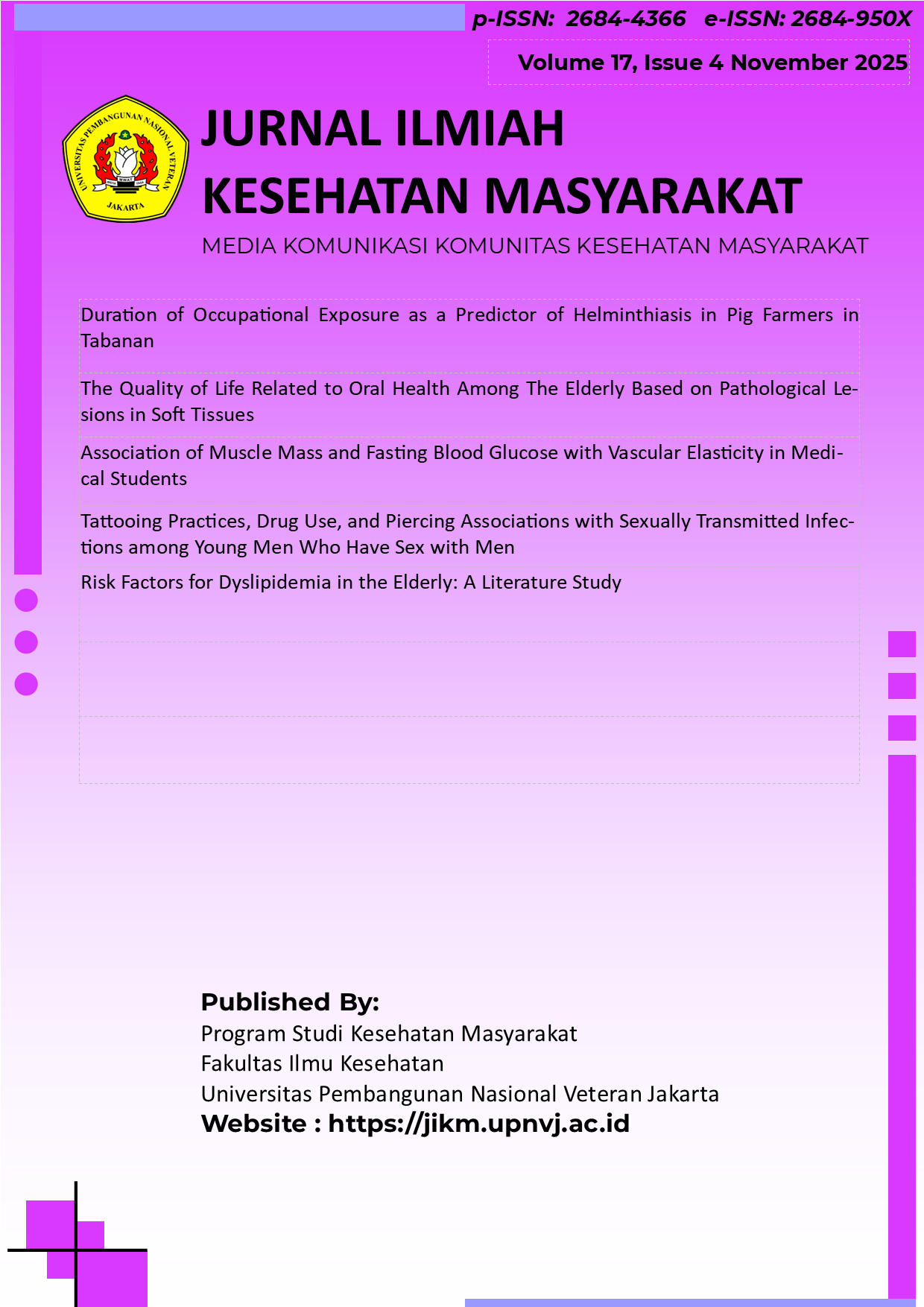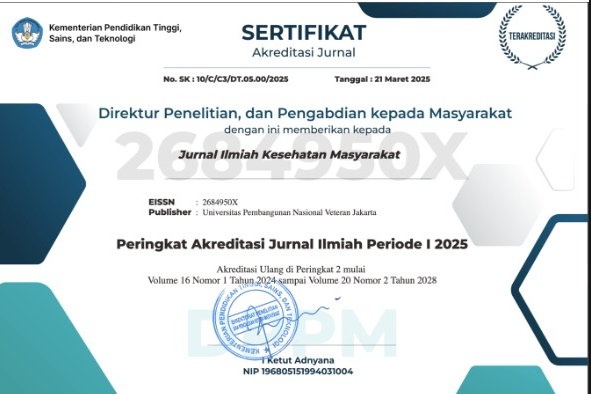Association of Muscle Mass and Fasting Blood Glucose with Vascular Elasticity in Medical Students
Abstract
Background: Low vascular elasticity is one of the key determinants of cardiovascular disease risk. Sedentary lifestyles and high-glucose diets may decrease muscle mass and increase blood glucose levels, potentially reducing vascular elasticity. This study aimed to analyze the relationships among muscle mass, fasting blood glucose levels, and vascular elasticity in medical students.
Methods: A cross-sectional study was conducted involving 53 medical students aged 18—22 years using a stratified random sampling technique. Eligible participants were non-smokers, non-alcohol consumers, and had no history of diabetes, hypertension, or the use of medications affecting blood pressure, blood glucose, or cholesterol levels. Muscle mass, fasting blood glucose, and vascular elasticity were measured using a bioelectrical impedance analyzer, capillary blood testing, and an accelerated photoplethysmograph, respectively. Data were analyzed using a Chi-square tests and multivariable Logistic Regression.
Results: There were no significant differences in age, blood pressure, BMI, or eating habits between the suboptimal and normal/optimal vascular elasticity groups (p > 0.05). Multivariable analysis showed that muscle mass was significantly associated with vascular elasticity (p = 0.009; OR = 9.656; CI = 1.757–53.075), after adjustment for fasting blood glucose levels (p = 0.386; OR = 2.329; CI = 0.344–15.776). Participants with higher muscle mass were nearly 10 times more likely to have better vascular elasticity.
Conclusion: Muscle mass is significantly associated with vascular elasticity in young adults, independent of fasting blood glucose levels. These findings highlight the importance of maintaining adequate muscle mass. Promoting muscle mass through healthy lifestyle habits may help preserve vascular elasticity and reduce the risk of cardiovascular disease.
References
Maharani A, Sujarwoto, Praveen D, Oceandy D, Tampubolon G, Patel A. Cardiovascular disease risk factor prevalence and estimated 10-year cardiovascular risk scores in Indonesia: The SMARThealth Extend study. PLoS One. 2019;14(4):1–13.
Papaioannou TG, Protogerou AD, Stergiopulos N, Vardoulis O, Stefanadis C, Safar M, et al. Total arterial compliance estimated by a novel method and all-cause mortality in the elderly: The PROTEGER study. Age (Omaha). 2014;36(3):1555–63.
Szaló G, Hellgren M, Allison M, Råstam L, Lindblad U, Daka B. Longitudinal association between leisure-time physical activity and vascular elasticity indices. BMC Cardiovasc Disord [Internet]. 2021;21(1):1–8. Available from: https://doi.org/10.1186/s12872-021-01911-z
Kemenkes RI. Hasil Riset Kesehatan Dasar Tahun 2018. Vol. 53, Kemenkes. 2018. 1689–1699 p.
Rafi Faiq A, Zulhamidah Y, Widayanti E. Gambaran Sedentary Behaviour dan Indeks Massa Tubuh Mahasiswa Fakultas Kedokteran Universitas YARSI di Masa Pendidikan Tahun Pertama dan Kedua. Majalah Sainstekes [Internet]. 2019;5(2):66–73. Available from: https://academicjournal.yarsi.ac.id/index.php/sainstekes/article/view/925/546
Smith L, Tully M, Jacob L, Blackburn N, Adlakha D, Caserotti P, et al. The association between sedentary behavior and sarcopenia among adults aged ≥65 years in low-and middle-income countries. Int J Environ Res Public Health. 2020;17(5):1–10.
Aminuddin A, Noor Hashim MF, Mohd Zaberi NAS, Zheng Wei L, Ching Chu B, Jamaludin NA, et al. The Association Between Arterial Stiffness and Muscle Indices Among Healthy Subjects and Subjects with Cardiovascular Risk Factors: An Evidence-Based Review. Front Physiol. 2021;12(November).
Gomez-Sanchez L, Garcia-Ortiz L, Patino-Alonso MC, Recio-Rodriguez JI, Fernando R, Marti R, et al. Association of metabolic syndrome and its components with arterial stiffness in Caucasian subjects of the MARK study: A cross-sectional trial. Cardiovasc Diabetol. 2016;15(1):1–12.
Kobayashi R, Sato K, Sakazaki M, Nagai Y, Iwanuma S, Ohashi N, et al. Acute effects of difference in glucose intake on arterial stiffness in healthy subjects. Cardiol J. 2021;28(3):446–52.
Mahriani Y, Indriyanti R, Musnamirwan IA, Setiawan AS. A cross-sectional study on dietary assessment, oral hygiene behavior, and oral health status of adolescent girls. Front Nutr. 2022;9(October):1–9.
Laksmi PW, Sukma FA, Setyohadi B, Nugroho P, Ariane A, Tirtarahardja G. The Need for a New Cut-off Value to Increase Diagnostic Performance of Bioelectrical Impedance Analysis Compared with Dual-Energy X-ray Absorptiometry to Measure Muscle Mass in Indonesian Elderly. Acta Med Indones. 2019;51(2):95–101.
Murakami T, Asai K, Kadono Y, Nishida T, Nakamura H, Kishima H. Assessment of arterial stiffness index calculated from accelerated photoplethysmography. Artery Res. 2019;25(1–2):37–40.
Vatner SF, Zhang J, Vyzas C, Mishra K, Graham RM, Vatner DE. Vascular Stiffness in Aging and Disease. Front Physiol. 2021;12(December):1–21.
DuPont JJ, Kenney RM, Patel AR, Jaffe IZ. Sex differences in mechanisms of arterial stiffness. Br J Pharmacol. 2019;176(21):4208–25.
Abramowitz MK, Hall CB, Amodu A, Sharma D, Androga L, Hawkins M. Correction: Muscle mass, BMI, and mortality among adults in the United States: A population-based cohort study (PLoS ONE (2018) 13:4 (e0194697) DOI: 10.1371/journal.pone.0194697). PLoS One. 2018;13(5):1–16.
Leed A, Sheridan E, Baker B, Bamford S, Emmanouilidis E, Stewart F, et al. Dietary Intake and Arterial Stiffness in Children and Adolescents: A Systematic Review. Nutrients. 2023;15(9):1–29.
Nurfadhilah K, Surialaga S, Ibnusantosa RG. Gambaran Persentase Total Massa Otot dan Total Massa Lemak Tubuh pada Golongan Dewasa Muda. Prosiding Pendidikan Dokter. 2018;4(2):613–9.
Limanan D, Ciptono F. Gambaran Profil Gula Darah Sewaktu Pada Mahasiswa Kedokteran. Jurnal Serina Sains, Teknik dan Kedokteran. 2023;1(1):47–52.
Noventi I, Rusdianingseh R, Khafid M. Prevalensi, Karakteristik dan Faktor Resiko Prediabetes di Wilayah Pesisir, Pegunungan dan Perkotaan. Jurnal Ners dan Kebidanan (Journal of Ners and Midwifery). 2019;6(3):371–81.
Park HE, Chung GE, Lee H, Kim MJ, Choi SY, Lee W, et al. Significance of Low Muscle Mass on Arterial Stiffness as Measured by Cardio-Ankle Vascular Index. Front Cardiovasc Med. 2022;9(June):1–8.
Sampaio RAC, Sewo Sampaio PY, Yamada M, Yukutake T, Uchida MC, Tsuboyama T, et al. Arterial stiffness is associated with low skeletal muscle mass in Japanese community-dwelling older adults. Geriatr Gerontol Int. 2014;14(SUPPL.1):109–14.
Im IJ, Choi HJ, Jeong SM, Kim HJ, Son JS, Oh HJ. The association between muscle mass deficits and arterial stiffness in middle-aged men. Nutrition, Metabolism and Cardiovascular Diseases. 2017;27(12):1130–5.
Gomez-Sanchez L, Garcia-Ortiz L, Patino-Alonso MC, Recio-Rodriguez JI, Feuerbach N, Marti R, et al. Glycemic markers and relation with arterial stiffness in Caucasian subjects of the MARK study. PLoS One. 2017;12(4):1–17.
Kaur R, Kaur M, Singh J. Endothelial dysfunction and platelet hyperactivity in type 2 diabetes mellitus: Molecular insights and therapeutic strategies. Cardiovasc Diabetol [Internet]. 2018;17(1):1–17. Available from: https://doi.org/10.1186/s12933-018-0763-3
Li Y, Liu Y, Liu S, Gao M, Wang W, Chen K, et al. Diabetic vascular diseases: molecular mechanisms and therapeutic strategies. Signal Transduct Target Ther. 2023;8(1).









.jpg)








